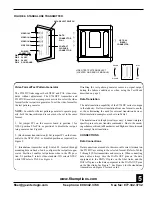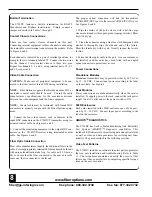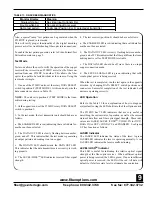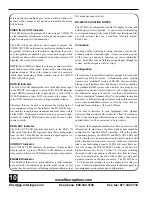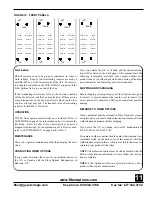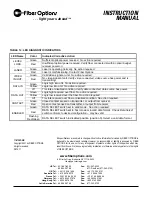
www.fiberoptions.com
free phone: 800.342.3748
free fax: 877.342.3732
10
If test patterns are enabled a grey screen with two white verti-
cal bars will be output. If test patterns are disabled the screen
will be black.
VIDEO IN (or OUT) Indicator
This LED indicates the presence of a video signal. VIDEO IN
on the transmitter remains green as long as an adequate video
signal is being input to the transmitter.
The LED will be red when no video signal is present. The
VIDEO OUT LED on the receiver performs a similar function,
except that it refers to the video that is output from the receiv-
er. If test patterns are enabled a grey screen with a single white
vertical bar pattern will be output when no video is present. If
disabled, the screen will be black.
NOTE:
The S734DV monitors the video sync signals to deter-
mine the presence of the signal. It does not monitor the picture
brightness signal. Thus, if the scene in front of a camera is
totally dark, producing a blank monitor screen, the VIDEO
LEDs will still be green.
DATA IN Indicator
The DATA IN LED indicates the state of the data being input
to the S734DV over copper. A green DATA IN LED indicates
a logic HIGH is present on the copper inputs. A yellow DATA
IN LED indicates a logic LOW is present on the copper. No
color (OFF) indicates a tri-state or high impedance input.
Therefore, this can be used to determine the resting state of
your equipment. Unique to the industry, the S734DV has spe-
cial circuitry to capture data transitions and make them visible
on the LEDs. High-speed bursts of activity, previously unde-
tectable by standard LED circuits, can easily be seen by this
special circuitry.
DATA OUT Indicator
The DATA OUT LED functions identically to the DATA IN
LED except that the LED represents data that is being output
from the unit. This LED has the same high-speed capture cir-
cuitry described in the DATA IN section.
CONTACT Indicator
The CONTACT LED indicates the presence of relay/contact
closure signals. A green CONTACT LED indicates a closed
relay contact, while a red LED indicates an open relay/contact.
ENABLED Indicator
This LED has three states; green indicates a valid mode has
been selected, red indicates an invalid mode (spare or test
mode) has been selected, or flashing red/green indicates that
NO mode has been selected.
RS-485 APPLICATION NOTES
The S734DV is configurable for both full-duplex (4-wire) and
half-duplex (2-wire) operation. It can be used for interfacing
to systems adhering strictly to the RS-485 specification and for
use with systems that use a modified, "fail-safe biased"
RS-485 bus.
Connection
Use high quality twisted-pair wiring, and make sure all con-
nection points are clean and tight. A loose connection on one
of the wires can appear to function, yet cause intermittent
errors: data LEDs may be flashing as signals pass through the
system, but those signals will be corrupt.
Configuration
Fiber Options Universal Data units are designed to work with
virtually any RS-485 system. Unfortunately, some systems
operate on a "modified" version of RS-485; they use failsafe
biasing to pull up/down their bus during a tri-state condition.
In a standard RS-485 system, when a driver on a properly ter-
minated bus goes into tri-state (inactive), the voltage between
the differential outputs should be less than 200 millivolts.
(This is considered "standard offset" in the product instruction
manuals). A differential output tri-state voltage this small can
cause some nonstandard systems to latch up, since they are
designed for much larger, "fail-safe," offsets.
To be able to interface to such equipment, Fiber Options
Universal Data products offer two more "offset" level modes.
That is, the maximum differential input voltage that can be
applied where it will be perceived to be in tri-state.
Of course, the equipment manufacturer does not disclose this
information. In most cases, the Fiber Options unit should be
configured for "standard offset" operation. When the system
is operating properly, the DATA IN and DATA OUT LEDs will
be off when there is no communication (tri-state) and they will
flash when data is being sent or received. In the case where the
link is not functioning properly, (LEDs will most likely not
turn off), change the DATA SELECT switch on the unit to a
higher offset mode. First try 1 V, then 2 V. If simply switching
the mode switch does not prove effective, the offset level may
have to be emulated at one end of the system by using pull-
up/down resistors on the data connector. The S734DV has a
+5 V bias pin and ground pins on the connector for this pur-
pose. Contact equipment manufacturer's technical support for
recommended resistor values and configuration.







